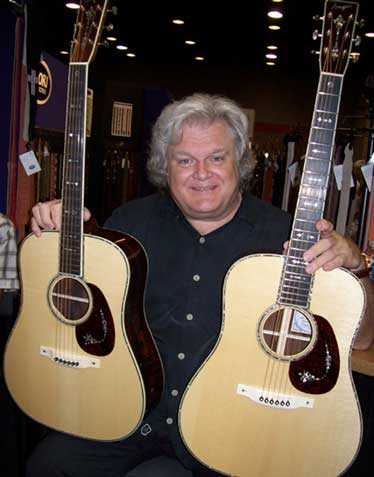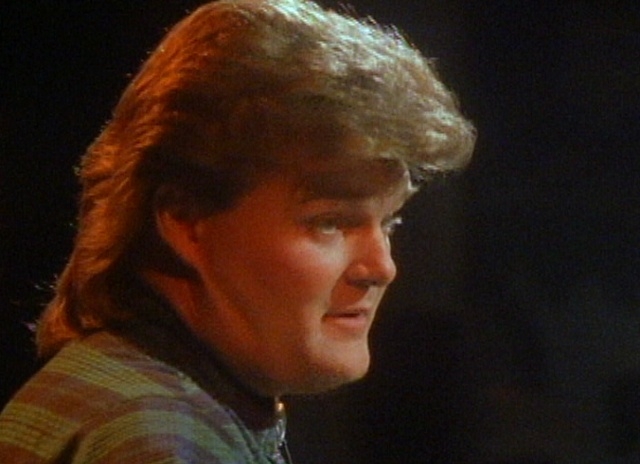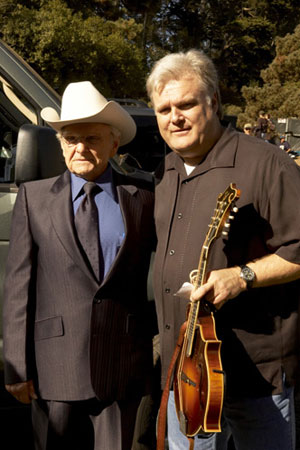Ricky Skaggs: ‘I’m always thankful, always grateful and always surprised when God shows up and shows off and does something cool in somebody’s heart. To me that is the ultimate goal of the music I play. That is the end-all. That’s the period at the end of the sentence. That’s it right there for me.’Back To The Source
On Country Hits Bluegrass Style, Ricky Skaggs recasts some of his ‘80s mega-hits in down-home fashion and, lo, he is pleased
By David McGee
Even as country music was sinking in an Urban Cowboy funk in 1980, there was hope for traditionalists on the horizon. What had been bubbling under since the emergence in the ‘70s of Emmylou Harris, Rosanne Cash and Rodney Crowell would gain traction in the early ‘80s when an impressive new generation of artists rooted in country fundamentals and well-versed in ‘50s and ‘60s rock ‘n’ roll charged out of the chute, ran the urban cowboys out of town and revitalized country from the ground up as the New Traditionalist movement.
Ricky Skaggs was one of those artists, and he would become one of the movement’s big dogs, starting with his #2 major label country album debut of 1981, Waitin’ For the Sun To Shine. In a decade that saw the rise of George Strait, Dwight Yoakam, The Judds, Foster & Lloyd, Kathy Mattea, Steve Earle, Lyle Lovett, Alan Jackson, et al., and with the then-married Rosanne and Rodney pushing the barriers of country with their Beatles-influenced work, Skaggs was a commercial force almost without parallel, and possibly the most subversive of all the New Traditionalists. While he was racking up no less than 11 #1 singles between 1981 and 1989, and another six Top 10 singles (of 25 singles released between 1981 and 1989, 11 were #1, 20 were Top 10, and he had a stretch between late ’81 and early ’83 of five consecutive chart topping singles) to go with five Top 10 albums (including three chart toppers in a row from ’82 to ’84), while he was leaving most of his New Traditionalist colleagues in the dust commercially, he was also making sure he never strayed far from his deepest musical roots by spicing many of his mainstream country hits with a smidgen of bluegrass flavor, whether that be in a certain ambience or some mandolin flavoring, and especially in the natural mountain cry in the native Kentuckian’s voice.
1980s vintage Ricky Skaggs: ‘One interviewer referred to me as a ‘neo-traditionalist’ and I had to look up the meaning…’At the same time, in interviews he made sure to correct writers who were picking up on the bluegrass tinge in his music by clarifying his style, and at the same paying homage to the true, unadulterated bluegrass that could still be heard being played by the man acknowledged as its father, Bill Monroe.
“One interviewer referred to me as a ‘neo-traditionalist,’ and I had to look up the meaning,” he says with a laugh in a recent interview from his home in Nashville. “In a lot of the interviews I was always having to explain myself. An interviewer would say to me, ‘I love this bluegrass music you’re doing,’ and I’d have to say, ‘Well, that’s not really bluegrass. Real bluegrass is…’ and I’d cite Mr. Monroe or Flatt and Scruggs, people like that and say, ‘What I do is more country with bluegrass mixtures.’ That’s my background; it’s always going to be kind of in there, so I would take ten minutes to explain bluegrass and the interview would be over. So I was always protecting Mr. Monroe and propping up everything he was doing so people wouldn’t mistake what I was doing and what he was still doing and what he had birthed. He birthed the real deal, and what I was doing was kind of a hybrid of that.”
Now it’s 2011, and Ricky Skaggs has come back to country. In a way. But at the same time, he’s never left bluegrass either. That is to say, on his new album, Country Hits Bluegrass Style, Skaggs revisits 14 of his monster country hits, including 10 of those #1 singles and, as the title indicates, recasts them into bluegrass songs. He does incorporate Paul Franklin’s steel guitar tears into the new treatment of “You’ve Got a Lover” (a #2 single in 1983 that broke a run of five consecutive #1 singles but was followed by three more consecutive #1s), which serve to heighten the heartbreak in Skaggs’s plaintive mountain voice, and he could not have helped but keep the Cajun accordion frolicking through “Cajun Moon” (#1, 1986), one of the most delightful, upbeat love songs in Skaggs’s entire catalogue. Only the stirring, string-enhanced spiritual testimony of “Somebody’s Prayin’,” which closes the album, fully breaks the bluegrass mold. Even so, closing on a gospel note is bluegrass style.
(Ed. note: Country Hits Bluegrass Style is an updated version of the album High Notes released by Cracker Barrel in a three-year exclusive deal and still available on the Cracker Barrel site only. Skaggs deleted “Cat’s In the Cradle,” his last Top 50 single [1996], from the High Notes tune stack [it remains available as a bonus track with an iTunes download, though] and added “Don’t Get Above Your Raising,” “I Don’t Care” and “He Was On To Something” to Country Hits Bluegrass Style. One Amazon customer expressed contempt for this strategy, claiming Skaggs either “has writer’s block or is winding down his career.” Do tell.)
In 1985 Ricky Skaggs’s version of Albert Lee’s ‘Country Boy’ was his ninth #1 single. On June 25, 2010, Skaggs got together in Chicago with Lee and other hot pickers, including Vince Gill and James Burton, for a rousing new version of the song.If anything, those familiar with the original smash hits populating Country Hits Bluegrass Style will likely be impressed how easily those country gems transition to bluegrass tunes. Ricky the subversive, you see, was never very far from bluegrass to begin with.
“You get that, you see it, you hear it,” a grateful Skaggs responded when this notion was run by him. He mentions seeing a capsule review recently in one of the established bluegrass publications describing the album as being “more country than bluegrass.”
“Oh, my God,” he moans. “Give me a break!
“I wanted to treat those songs in a bluegrass way, but there were certain songs I felt I had to get the steel guitar on there, ‘You’re Not a Lover,’ things like that. That was the intro and it was so important to the sound of the song, and I felt I had to be true and honest to things like that and ‘I Don’t Care’ and ‘He Was On To Something’; but for the most part things like ‘Country Boy’ I think is a better cut than the original. I honestly do. I think it’s more animated and just crazier. ‘Heartbreaker,’ playing a stringbender acoustic guitar as opposed to the electric. It’s funny, it’s almost like a Pickin’ On Ricky Skaggs album, like someone would do a bluegrass version of Ricky Skaggs songs. I’m real happy with it.”
The early ‘90s were not as chart friendly to Skaggs as the ‘80s had been, but that was also a time when the New Traditionalists were being pushed aside, along with veteran artists who had preceded and been embraced by them and their audiences, in favor of the arena country pyrotechnics of Garth Brooks and the like, but especially Garth. Frustrated, Skaggs did what few big-time mainstream artists have the courage to do: he walked away, returning from whence he came, the bluegrass world, and there he dwells.
With Ralph StanleyBorn in Cordell, Kentucky, Skaggs was playing mandolin live on stage with Bill Monroe at the age of six. In his mid-teens he had teamed up another teen prodigy, Keith Whitley, plus Keith’s brother Dwight, and was playing regularly on the radio. In 1970, 16-year-old Ricky, along with Keith Whitley, joined Ralph Stanley’s Clinch Mountain Boys. From there it was on to a tenure in J.D. Crowe’s trailblazing New South; and from there on to Emmylou’s Hot Band, playing mandolin and fiddle, arranging, and producing two acclaimed albums for Harris, 1979’s holiday classic, Light of the Stable (which kicked off with a feisty rendition of Bill Monroe’s Yuletide evergreen, “Christmas Time’s a-Coming”) and 1980’s bluegrass-centric Roses In the Snow. As a solo artist his debut came in 1975, That’s It, on Rebel, followed four years later by Sweet Temptation on Sugar Hill. When he signed with Epic in 1980, Skaggs made a conscious move into the commercial country mainstream, though still working bluegrass into his live shows, and thrived, as noted above.
Given that in some cases more than two decades have passed since the earliest songs on Country Hits Bluegrass Style were new to him, a question arises as to whether the passing of time and the recasting of the songs into bluegrass numbers had deepened Skaggs’s appreciation for his hits of yore. Indeed, he says, the acoustic-based arrangements enhanced his appreciation not only for the lyrics but also for the very construction of the songs. Moreover, the more relaxed pace of his career now enables him a better chance to smell the roses than time permitted during his years as a reigning country superstar.
Seven-year-old Ricky Skaggs picks ‘Foggy Mountain Special’ with Flatt & Scruggs on the Martha White-sponsored Flatt & Scruggs TV show, 1961“One of the things I did understand in doing these things more acoustic was not having the loud drums--I think we used a lot of percussion on some of these tracks with Larry Eagle--but one of the things was how well you could hear the vocal,” he says. “How well you could really understand the lyrics in a more unplugged, kind of dressed down presentation, how much better the vocals were, easy to understand, you could follow along with the lyrics. So I felt they really worked well in an unplugged situation. That was one of the things that caught my ear.
“And really, too, in going back in and re-cutting these things, how easy they were to sing again. So many times when we would get a new song like ‘You’ve Got a Lover’ or ‘He Was On To Something’ or ‘Let It Be You’ or something new that came to new from the Music Row songwriters—not old songs like ‘Don’t Cheat’ or things that I had sung for years in bluegrass prior to all that--I would learn these songs, then we’d cut a track, I’d go in the studio and sing ‘em, and then I’d go on the road and learn them. You never learn a song in the studio. Or I don’t. I was talking to Connie Smith down at the Hall of Fame where she was doing an Artist in Residence thing, and she was saying RCA required her to do two albums a year and four extra singles, every year she was on the label. My goodness! Good Lord, they could never have got two albums a year out of me. They were lucky to get one every sixteen months, as much as we were on the road. I’d get these songs and sing ‘em in the studio, but I really didn’t get to the point where I could do them well enough to get them into my heart and mind and be able to really think about what the song says and what it means until I was out on the road performing them. So that was one of the things that I really enjoyed about going in and being in front of the microphone this time as opposed to last time.”
Ricky Skaggs, ‘He Was On To Something (So He Made You),’ from Country Hits Bluegrass Style. The original single was a #25 country hit in 1990.Only one song on the album was not a chart wrecking hit for Skaggs; in fact, it wasn’t even a single. But of the 15 songs on Country Hits Bluegrass Style, this is the one closest to his heart, owing to his deeply religious nature. “Somebody’s Prayin’” closes the album on a spiritually uplifting note and is given the big production flourishes, complete with strings, more typical of a Gaither Homecoming album--indeed, Skaggs has performed it at Gaither gatherings over the years. As a song Skaggs has been performing live for some time, “Somebody’s Prayin’” is familiar fare to his fans, one of whom, James Walker of Lompoc, CA, wrote a heartfelt letter to the website singersclub.com, commenting equally on how much he liked the new album and how moved he was by “Somebody’s Prayin’.” Wrote Walker: “I saw Ricky Skaggs sing this at a bluegrass festival. It is a very powerful song. I felt the Holy Spirit when he sang it live and still feel the presence when I hear it. What a blessing from God through a wonderful person.”
Hearing this read back to him, Skaggs takes a breath. Asked how this kind of reaction makes him feel, he pauses again. “I just thank God, I really do,” he says, his voice cracking. “I’m so moved and so thankful that somebody on the receiving end—I feel like I’m receiving it and getting something from it every time I sing it. But I’m just so grateful that God would choose to use a cracked pot, a vessel, like me to bring his spirit through so that someone can be touched and be moved and can sense God’s presence.”
Gathering himself, he considers this moment with respect to his larger aims as an artist: “I try not to make it about a performance, but that’s what I am—I’m a performer, I’m an artist, I’m a singer. Some people lead worship—my youngest two kids are worship leaders, and not performers. They grew up in a performing family with Sharon and me. They have dedicated their lives to leading worship and leading others into worship. That’s a thing that’s really foreign to me. Churches and people will say, ‘Hey, we’d love for you to come down and lead worship.’ ‘Well, I don’t really feel like I do that.’ And Sharon says, ‘Ricky, you have to quit saying that. You do lead!’ Maybe for a fleeting moment, for that three minutes and 24 seconds that ‘Somebody’s Prayin’’ is, maybe someone was worshiping while I sung that—not worshipping me but worshipping the creator. It’s the most wonderful thing in the world. With Mosaic and what God did through that record—we could talk another hour on just what happened with Mosaic. [Ed. note: Mosaic, Skaggs’s 2010 Contemporary Christian album, is a stylistically diverse collection of inspiring, enriching, spiritually oriented messages that received near-universal critical acclaim.] It’s unbelievable—never, ever had a record that caused people to call the office and order a hundred copies at a time to give away to family members and friends. Never have I ever done a record like that.
Ricky Skaggs, ‘Somebody’s Prayin’’: ‘Those are the things that to me lay up treasures in Heaven that moths and worms can’t eat, can’t destroy. Those are the things I hope will cause the Lord to say, when I see Him, ‘Well done, good and faithful servant.’ That’s what I really want to hear, not, ‘Man, you’re lucky to be here, I’ll tell you that!’’“So I can just say I’m always thankful, always grateful and always surprised when God shows up and shows off and does something cool in somebody’s heart. To me that is the ultimate goal of the music I play. That is the end-all. That’s the period at the end of the sentence. That’s it right there for me. Not the records sold, not the Grammys, not Entertainer of the Year, not any of that. Those are keys that unlock doors that open up to other purposes. So to hear something like that letter is the greatest compliment I could ever have in my entire life. Those are the things that to me lay up treasures in Heaven that moths and worms can’t eat, can’t destroy. Those are the things that I hope will cause the Lord to say, when I see Him, ‘Well done, good and faithful servant.’ That’s what I really want to hear, not, ‘Man, you’re lucky to be here, I’ll tell you that!’”
The interview with Ricky Skaggs will continue in our December issue, when he discusses the new A Skaggs Family Christmas Volume Two, a spectacular holiday release featuring the full Skaggs Family Christmas show on CD and on DVD, in an attractive package priced at an attractive $15.
Ricky Skaggs’s Country Hits Bluegrass Style is available at www.amazon.com
Founder/Publisher/Editor: David McGee
Contributing Editors: Billy Altman, Laura Fissinger, Christopher Hill, Derk Richardson
Logo Design: John Mendelsohn (www.johnmendelsohn.com)
Website Design: Kieran McGee (www.kieranmcgee.com)
Staff Photographers: Audrey Harrod (Louisville, KY; www.flickr.com/audreyharrod), Alicia Zappier (New York)
E-mail: thebluegrassspecial@gmail.com
Mailing Address: David McGee, 201 W. 85 St.—5B, New York, NY 10024





